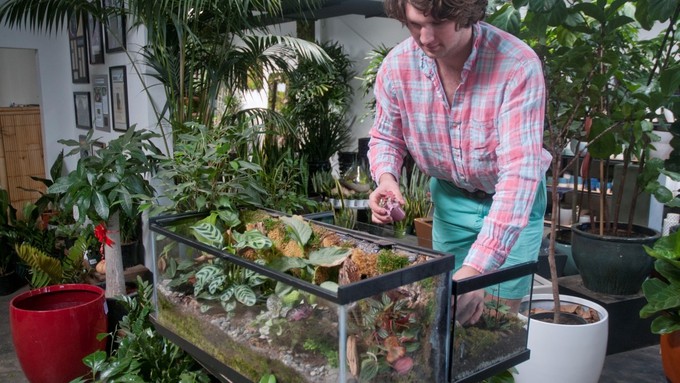
Learn how to create a bioactive terrarium to take home

An Exotic Plants staff member builds a large terrarium at the store. A "Glass Gardens" workshop will be held there this Saturday, June 29. Photo courtesy Exotic Plants
When it’s hot outdoors, you can still garden indoors. Create your own cool, green world during “Glass Gardens: Terrarium Crafting Experience,” a special workshop offered by Exotic Plants in Sacramento.
Set for 4 p.m. Saturday, June 29, the two-hour class will cover the basics of building terrariums that help take care of themselves.
“Join us for an immersive and hands-on experience in the world of bioactive terrariums!” says the organizers. “In this workshop, you'll have the opportunity to unleash your creativity and build your very own self-sustaining mini ecosystem.”
At its store on Fulton Avenue, Exotic Plants is well known for its terrariums, including reptile and amphibian habits. Several are on display and tended by store staff.
During this workshop, participants will create their own terrariums to take home. Fee for the class ($60-$85) is based on size and style of the glass garden.
Includes are: All materials and tools needed to create your bioactive terrarium; a wide selection of plants, mosses, and bioactive elements; plus expert guidance and hands-on assistance throughout the workshop.
“Our experienced instructors will lead you through the process, providing expert tips on choosing the right plants, creating layers, and maintaining a healthy, thriving terrarium,” say the hosts. “Explore a diverse selection of plants, mosses, and small creatures that will coexist harmoniously in your bioactive terrarium. Learn about their unique requirements and contributions to the ecosystem.
“From the ground up, you’ll design and assemble the layers that make up this self-contained world,” they add. “Witness the magic as you transform an empty vessel into a thriving green oasis.”
Once started correctly, bioactive terrariums almost take care of themselves. Maintenance tips are part of the package.
“Learn how to care for your terrarium to ensure it remains a vibrant and healthy ecosystem for years to come,” they say. “Understand the key elements of watering, lighting, and periodic maintenance.”
A few seats are still available; register now on Eventbrite.com at this link: https://shorturl.at/xdhmD
Exotic Plants is located at 1525 Fulton Ave., Sacramento.
Details and directions: https://www.exoticplantsltd.com/.
Comments
0 comments have been posted.Sacramento Digs Gardening to your inbox.
Food in My Back Yard Series
May 6: Maintain soil moisture with mulch for garden success
April 29: What's (already) wrong with my tomato plants?
April 22: Should you stock up on fertilizer? (Yes!)
April 15: Grow culinary herbs in containers
April 8: When to plant summer vegetables
April 1: Don't be fooled by these garden myths
March 25: Fertilizer tips: How to 'feed' your vegetables for healthy growth
March 18: Time to give vegetable seedlings some more space
March 11: Ways to win the fight against weeds
March 4: Potatoes from the garden
Feb. 25: Plant a fruit tree now -- for later
Feb. 18: How to squeeze more food into less space
Feb. 11: When to plant? Consider staggering your transplants
Feb. 4: Starting in seed starting
Sites We Like
Garden Checklist for week of May 11
Make the most of the lower temperatures early in the week. We’ll be back in the 80s by Thursday.
* Plant, plant, plant! It’s prime planting season in the Sacramento area. Time to set out those tomato transplants along with peppers and eggplants. Pinch off any flowers on new transplants to make them concentrate on establishing roots instead of setting premature fruit.
* Direct-seed melons, cucumbers, summer squash, corn, radishes, pumpkins and annual herbs such as basil.
* Harvest cabbage, lettuce, peas and green onions.
* In the flower garden, direct-seed sunflowers, cosmos, salvia, zinnias, marigolds, celosia and asters. (You also can transplant seedlings for many of the same flowers.)
* Plant dahlia tubers.
* Transplant petunias, marigolds and perennial flowers such as astilbe, columbine, coneflowers, coreopsis, dahlias, rudbeckia and verbena.
* Keep an eye out for slugs, snails, earwigs and aphids that want to dine on tender new growth.
* Feed summer bloomers with a balanced fertilizer.
* For continued bloom, cut off spent flowers on roses as well as other flowering plants.
* Add mulch to the garden to maintain moisture. Mulch also cuts down on weeds. But don’t let it mound around the stems or trunks of trees or shrubs. Leave about a 6-inch-to-1-foot circle to avoid crown rot or other problems.
* Remember to weed! Pull those nasties before they set seed.
* Water early in the day and keep seedlings evenly moist.